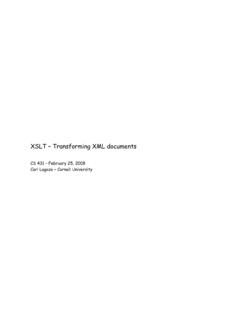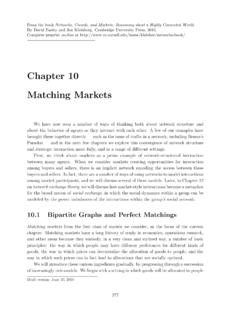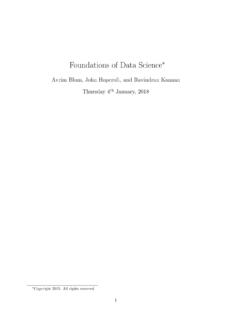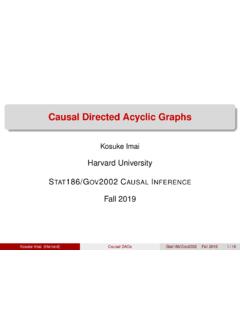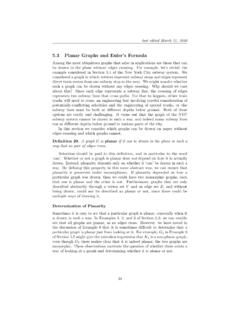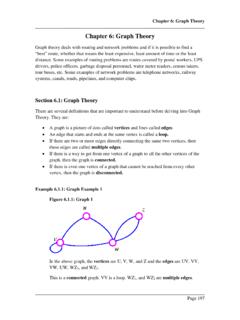Transcription of Chapter 2 Graphs - Cornell University
1 Chapter 2 GraphsFrom the bookNetworks, Crowds, and Markets: Reasoning about a Highly Connected David Easley and Jon Kleinberg. Cambridge University Press, preprint on-line at this first part of the book we develop some of the basic ideas behind graph theory,the study of network structure. This will allow us to formulate basic network properties in aunifying language. The central definitions here are simple enough that we can describe themrelatively quickly at the outset; following this, we consider some fundamental applicationsof the Basic DefinitionsGraphs: Nodes and a way of specifying relationships among a collec-tion of items. A graph consists of a set of objects, callednodes, with certain pairs of theseobjects connected by links callededges. For example, the graph in Figure (a) consistsof 4 nodes labeledA,B,C, andD, withBconnected to each of the other three nodes byedges, andCandDconnected by an edge as well. We say that two nodes areneighborsifthey are connected by an edge.
2 Figure shows the typical way one draws a graph withlittle circles representing the nodes, and a line connecting each pair of nodes that are linkedby an Figure (a), you should think of the relationship between the two ends of an edge asbeing symmetric; the edge simply connects them to each other. In many settings, however,we want to express asymmetric relationships for example, thatApoints toBbut notvice versa. For this purpose, we define adirected graphto consist of a set of nodes, asbefore, together with a set ofdirected edges; each directed edge is a link from one nodeto another, with the direction being important. Directed Graphs are generally drawn as inFigure (b), with edges represented by arrows. When we want to emphasize that a graphis not directed, we can refer to it as anundirected graph ; but in general the Graphs we discussDraft version: June 10, 20102324 Chapter 2. GRAPHSBACD(a)A graph on 4 (b)A directed graph on 4 : Two Graphs : (a) an undirected graph , and (b) a directed be undirected unless noted as Models of are useful because they serve as mathematicalmodels of network structures.
3 With this in mind, it is useful before going further to replacethe toy examples in Figure with a real example. Figure depicts the network structureof the Internet then called the Arpanet in December 1970 [214], when it had only 13sites. Nodes represent computing hosts, and there is an edge joining two nodes in this pictureif there is a direct communication link between them. Ignoring the superimposed map of (and the circles indicating blown-up regions in Massachusetts and Southern California),the rest of the image is simply a depiction of this 13-node graph using the same dots-and-linesstyle that we saw in Figure Note that for showing the pattern of connections, the actualplacement or layout of the nodes is immaterial; all that matters is which nodes are linkedto which others. Thus, Figure shows a different drawing of the same 13-node appear in many domains, whenever it is useful to represent how things are eitherphysically or logically linked to one another in a network structure.
4 The 13-node Arpanet inFigures and is an example of acommunication network, in which nodes are computersor other devices that can relay messages, and the edges represent direct links along whichmessages can be transmitted. In Chapter 1, we saw examples from two other broad classes ofgraph structures:social networks, in which nodes are people or groups of people, and edgesrepresent some kind of social interaction; andinformation networks, in which the nodesare information resources such as Web pages or documents, and edges represent PATHS AND CONNECTIVITY25 Figure : A network depicting the sites on the Internet, then known as the Arpanet, inDecember 1970. (Image from F. Heart, A. McKenzie, J. McQuillian, and D. Walden [214];on-line at )connections such as hyperlinks, citations, or cross-references. The list of areas in whichgraphs play a role is of course much broader than what we can enumerate here; Figure a few further examples, and also shows that many images we encounter on a regularbasis have Graphs embedded in Paths and ConnectivityWe now turn to some of the fundamental concepts and definitions surrounding Graphs .
5 Per-haps because Graphs are so simple to define and work with, an enormous range of graph -theoretic notions have been studied; the social scientist John Barnes once described graphtheory as a terminological jungle, in which any newcomer may plant a tree [45]. Fortu-nately, for our purposes, we will be able to get underway with just a brief discussion of someof the most central 2. GRAPHSLINCCASECARNHARVBBNMITSDCRANDUTAHS RIUCLASTANUCSBF igure : An alternate drawing of the 13-node Internet graph from December we ve been discussing examples of Graphs in many different areas, thereare clearly some common themes in the use of Graphs across these areas. Perhaps foremostamong these is the idea that things often travel across the edges of a graph , moving fromnode to node in sequence this could be a passenger taking a sequence of airline flights, apiece of information being passed from person to person in a social network, or a computeruser or piece of software visiting a sequence of Web pages by following idea motivates the definition of apathin a graph : a path is simply a sequence ofnodes with the property that each consecutive pair in the sequence is connected by an it is also useful to think of the path as containing not just the nodes but also thesequence of edges linking these nodes.
6 For example, the sequence of nodesmit, bbn, rand,uclais a path in the Internet graph from Figures and , as is the sequencecase,lincoln, mit, utah, sri, ucsb. As we have defined it here, a path can repeat nodes: forexample,sri, stan, ucla, sri, utah, mitis a path . But most paths we consider will notdo this; if we want to emphasize that the path we are discussing does not repeat nodes, wecan refer to it as asimple particularly important kind of non-simple path is acycle, which informally is a ring structure such as the sequence of nodeslinc, case, carn, harv, bbn, mit, lincon the right-hand-side of Figure More precisely, a cycle is a path with at least threeedges, in which the first and last nodes are the same, but otherwise all nodes are are many cycles in Figure :sri, stan, ucla, sriis as short an example as possibleaccording to our definition (since it has exactly three edges), whilesri, stan, ucla, rand,bbn, mit, utah, sriis a significantly longer fact, every edge in the 1970 Arpanet belongs to a cycle, and this was by design: it meansthat if any edge were to fail ( a construction crew accidentally cut through the cable),there would still be a way to get from any node to any other node.
7 More generally, PATHS AND CONNECTIVITY27(a)Airline routes(b)Subway map(c)Flowchart of college courses(d)Tank Street Bridge in BrisbaneFigure :Images of Graphs arising in different domains. The depictions of airline and subway systemsin (a) and (b) are examples oftransportation networks, in which nodes are destinations and edges representdirect connections. Much of the terminology surrounding Graphs derives from metaphors based on transporta-tion through a network of roads, rail lines, or airline flights. The prerequisites among college courses in (c) isan example of adependency network, in which nodes are tasks and directed edges indicate that one task mustbe performed before another. The design of complex software systems and industrial processes often requiresthe analysis of enormous dependency networks, with important consequences for efficient scheduling in thesesettings. The Tank Street Bridge from Brisbane, Australia shown in (d) is an example of astructural network,with joints as nodes and physical linkages as edges.
8 The internal frameworks of mechanical structures such asbuildings, vehicles, or human bodies are based on such networks, and the area ofrigidity theory, at the inter-section of geometry and mechanical engineering, studies the stability of such structures from a graph -basedperspective [388]. (Images: (a) , (b) , (c) )28 Chapter 2. GRAPHSFGHJIKLABCEDMF igure : A graph with three connected communication and transportation networks are often present to allow for redundancy they provide for alternate routings that go the other way around the cycle. In the socialnetwork of friendships too, we often notice cycles in everyday life, even if we don t refer tothem as such. When you discover, for example, that your wife s cousin s close friend fromhigh school is in fact someone who works with your brother, this is a cycle consistingof you, your wife, her cousin, his high-school-friend, his co-worker ( your brother), andfinally back to a graph , it is natural to ask whether every node can reach everyother node by a path .
9 With this in mind, we say that a graph isconnectedif for every pair ofnodes, there is a path between them. For example, the 13-node Arpanet graph is connected;and more generally, one expects most communication and transportation networks to beconnected or at least aspire to be connected since their goal is to move traffic fromone node to the other hand, there is noa priorireason to expect Graphs in other settings to beconnected for example, in a social network, you could imagine that there might exist twopeople for which it s not possible to construct a path from one to the other. Figures give examples of disconnected Graphs . The first is a toy example, while the secondis built from the collaboration graph at a biological research center [134]: nodes PATHS AND CONNECTIVITY29 Figure : The collaboration graph of the biological research centerStructural Genomics ofPathogenic Protozoa (SGPP)[134], which consists of three distinct connected graph was part of a comparative study of the collaboration patterns Graphs of nineresearch centers supported by NIH s Protein Structure Initiative; SGPP was an intermediatecase between centers whose collaboration graph was connected and those for which it wasfragmented into many small , and there is an edge between two nodes if the researchers appear jointly on aco-authored publication.
10 (Thus the edges in this second figure represent a particular formaldefinition of collaboration joint authorship of a published paper and do not attempt tocapture the network of more informal interactions that presumably take place at the researchcenter.) and make visually apparent a basic fact about disconnectedgraphs: if a graph is not connected, then it breaks apart naturally into a set of connected pieces, groups of nodes so that each group is connected when considered as a graph inisolation, and so that no two groups overlap. In Figure , we see that the graph consistsof three such pieces: one consisting of nodesAandB, one consisting of nodesC,D, andE,and one consisting of the rest of the nodes. The network in Figure also consists of threepieces: one on three nodes, one on four nodes, and one that is much make this notion precise, we we say that aconnected componentof a graph (oftenshortened just to the term component ) is a subset of the nodes such that: (i) every nodein the subset has a path to every other; and (ii) the subset is not part of some larger setwith the property that every node can reach every other.

